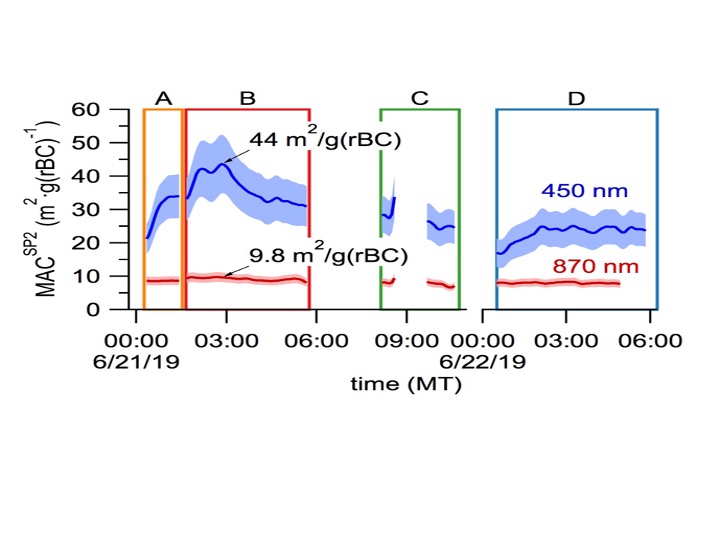Aging and mixing reduces wildfire smoke warming
Submitter
Dubey, Manvendra K.
— Los Alamos National Laboratory
Area of Research
Aerosol Properties
Journal Reference
Lee J, M Dubey, A Aiken, P Chylek, and C Carrico. 2020. "Optical and chemical analysis of absorption enhancement by mixed carbonaceous aerosols in the 2019 Woodbury, AZ fire plume." Journal of Geophysical Research: Atmospheres, 125(15), e2020JD032399, 10.1029/2020JD032399.
Science

Figure 1. Total mass absorption cross-sections of BC and BrC of smoke using the measured BC mass is much greater than for pure BC. This access is attributed to coating enhancement in the red and additional absorption by BrC in the blue. From journal.
Wildfires emit black and brown carbon (BC and BrC) aerosols that can warm climate by absorbing sunlight but their treatments in models is idealized and uncertain. Observations of the aged 2019 Woodbury, Arizona fire show that high absorption efficiency that is attributed to coated BC and BrC particles. However, as the plume mixes with ambient air, BrC absorption cross-sections decrease, thereby reducing their climate-warming power.
Impact
Absorption of sunlight by BC and BrC in wildfire smoke warms climate. The absorption by BC that is stable is much better known than that by BrC that is labile. Analysis of the Woodbury fire smoke plume after half a day of transport shows that the aging and mixing reduces BrC absorption efficiency. The effects of these processes that occur at scales smaller than the resolution of climate models need to be included and will reduce the estimated warming by wildfire smoke.
Summary
Wildfires emit mixtures of light‐absorbing BC and BrC and scattering organic aerosols. These aerosols interact and their properties evolve with age by processes that are ill understood and that large uncertainties in their climate forcing. We measured optical and chemical properties of Woodbury Fire smoke at Los Alamos, New Mexico after 10-18 hours of transit. We find aerosol mass absorption cross‐sections (MACs) were enhanced by a factor of 1.5‐2.2 over bare BC at 870 nm, suggesting lensing by coatings. Larger MAC enhancement factors of 1.9‐5.1 at 450 nm were greater than core‐shell morphology can explain and are attributed to BrC. The BrC absorption (MACorg) at 450 nm was largest in intact portions of the plumes (0.6‐0.9 m2/g) and decreased with plume dilution. MACorg (450 nm) is correlated to flevoglucosan of organic coating indicating that BrC was co‐emitted with a tracer for primary aerosol emissions. MACorg (450 nm) is inversely related to oxidized organic tracers and carbon monoxide demonstrating that BrC is bleached as the plume mixes with ambient air. Our findings should reduce the warming by BrC in climate models.
Keep up with the Atmospheric Observer
Updates on ARM news, events, and opportunities delivered to your inbox
ARM User Profile
ARM welcomes users from all institutions and nations. A free ARM user account is needed to access ARM data.


















